Western Digital WD2500YD: Enterprise on the Desktop
by Gary Key on June 24, 2006 10:00 AM EST- Posted in
- Storage
iPEAK File Transfer Tests
Our iPEAK based File Transfer benchmarks indicate how well a drive performs in a strictly read or write operation with a limited number of files (29) but a large amount of data (7.55GB). The test is designed to ensure continual write or read operations across a large section of the drive that requires constant head and actuator movements along with caching large amounts of data.
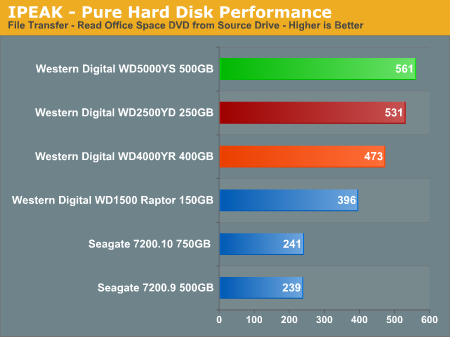
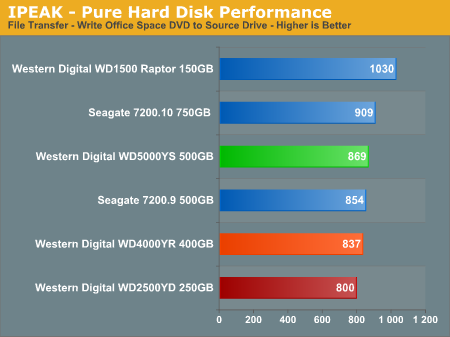
The read performance of the WD2500YD is impressive in these benchmarks while the write performance continues to be lackluster when compared to the other drives. The performance of WD RE2 500GB drive was fantastic in the read section and then fell in behind the WD Raptor and Seagate 7200.10 in the write performance benchmark; however, it continues to lead the RE2 400GB drive in both benchmarks.
The Seagate 7200.10 and 7200.9 read performance is dismal compared to the WD drives, but their write performance is very good. This is interesting as their read performance in the antivirus test was excellent. After further examination of the trace files we noticed the read requests in the antivirus test consisted of mostly small blocks sizes in irregular patterns compared to very large block sizes in a continual pattern in the file transfer test. Apparently, the Seagate drives handle small transfers better than sustained larger transfers, so the large files used here hampered their performance.
iPEAK Video/Audio Tests
The iPEAK based Video/Audio benchmarks are designed around media encoding and simulating HTPC activities. These are basic benchmarks at this time as this section will be expanded greatly with some new tools that we have developed that will be introduced in our 500GB roundup. Our change to a dual core processor will assist us in maintaining a balance between the CPU and Storage systems during the trace file creation and benchmarking processes. These benchmarks are CPU intensive in nature but also require a balanced storage system with the ability to handle read and write requests simultaneously in a very efficient manner.
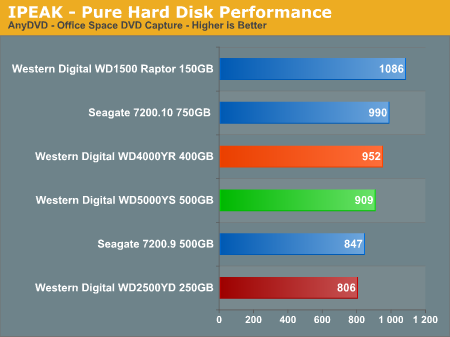
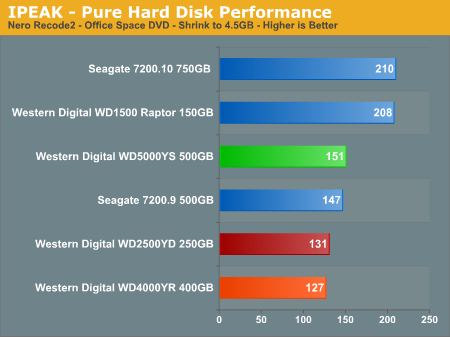
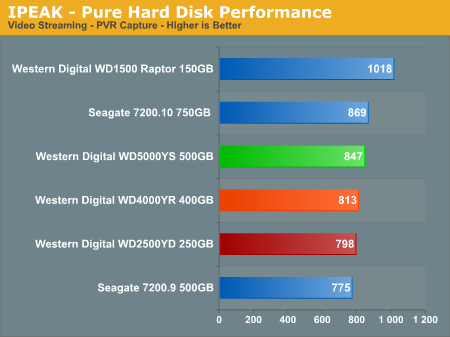
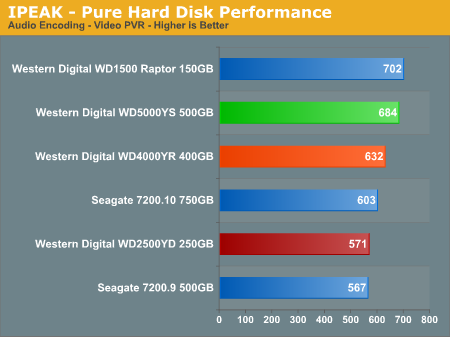
The AnyDVD benchmark is heavily weighted to write requests with the results showing a common pattern with the WD Raptor finishing first and the WD2500YD trails behind the balance of the field. The WD RE2 400GB drive finishes slightly ahead of the RE2 500GB and 18% ahead of the RE 250GB drive. The Seagate 750GB 7200.10 posts very good scores in this area and should since its capacity lends itself well to this process.
The NeroRecode 2 benchmark is weighted to streaming read requests but is balanced by continuous write operations. This benchmark is one of the most demanding ones in our test suite with the disk being active the entire trace file with several 100% utilization peaks. The Seagate 7200.10 posts the best scores here with a victory over the Raptor and finishes ahead of the other WD drives. The WD2500YD places ahead of the RE2 400GB but does not offer the same strong read performance we noticed in the file transfer tests where a limited number of like file sizes are utilized.
Our video and audio encoding benchmarks that stream a continuous data feed clearly favor the high and sustainable transfer rates of the Raptor. While falling behind the RE2 drives in these two benchmarks, the WD2500YD has no trouble finishing ahead of the Seagate 7200.9 500GB drive. The Seagate 7200.10 and WD5000YS both offer very balanced performance in the larger drive capacities.
Our iPEAK based File Transfer benchmarks indicate how well a drive performs in a strictly read or write operation with a limited number of files (29) but a large amount of data (7.55GB). The test is designed to ensure continual write or read operations across a large section of the drive that requires constant head and actuator movements along with caching large amounts of data.


The read performance of the WD2500YD is impressive in these benchmarks while the write performance continues to be lackluster when compared to the other drives. The performance of WD RE2 500GB drive was fantastic in the read section and then fell in behind the WD Raptor and Seagate 7200.10 in the write performance benchmark; however, it continues to lead the RE2 400GB drive in both benchmarks.
The Seagate 7200.10 and 7200.9 read performance is dismal compared to the WD drives, but their write performance is very good. This is interesting as their read performance in the antivirus test was excellent. After further examination of the trace files we noticed the read requests in the antivirus test consisted of mostly small blocks sizes in irregular patterns compared to very large block sizes in a continual pattern in the file transfer test. Apparently, the Seagate drives handle small transfers better than sustained larger transfers, so the large files used here hampered their performance.
iPEAK Video/Audio Tests
The iPEAK based Video/Audio benchmarks are designed around media encoding and simulating HTPC activities. These are basic benchmarks at this time as this section will be expanded greatly with some new tools that we have developed that will be introduced in our 500GB roundup. Our change to a dual core processor will assist us in maintaining a balance between the CPU and Storage systems during the trace file creation and benchmarking processes. These benchmarks are CPU intensive in nature but also require a balanced storage system with the ability to handle read and write requests simultaneously in a very efficient manner.




The AnyDVD benchmark is heavily weighted to write requests with the results showing a common pattern with the WD Raptor finishing first and the WD2500YD trails behind the balance of the field. The WD RE2 400GB drive finishes slightly ahead of the RE2 500GB and 18% ahead of the RE 250GB drive. The Seagate 750GB 7200.10 posts very good scores in this area and should since its capacity lends itself well to this process.
The NeroRecode 2 benchmark is weighted to streaming read requests but is balanced by continuous write operations. This benchmark is one of the most demanding ones in our test suite with the disk being active the entire trace file with several 100% utilization peaks. The Seagate 7200.10 posts the best scores here with a victory over the Raptor and finishes ahead of the other WD drives. The WD2500YD places ahead of the RE2 400GB but does not offer the same strong read performance we noticed in the file transfer tests where a limited number of like file sizes are utilized.
Our video and audio encoding benchmarks that stream a continuous data feed clearly favor the high and sustainable transfer rates of the Raptor. While falling behind the RE2 drives in these two benchmarks, the WD2500YD has no trouble finishing ahead of the Seagate 7200.9 500GB drive. The Seagate 7200.10 and WD5000YS both offer very balanced performance in the larger drive capacities.










11 Comments
View All Comments
Calin - Monday, June 26, 2006 - link
On RealTimePricing a 150GB Raptor is at $260. Could you throw a comparation with one of the cheaper 147GB SCSI models (at around $350)? If one want more performance and consider paying $260 for a Raptor instead a bit less for three times the capacity, they could accept paying one and a half times the price for a third the capacity in a SCSI drive.With considerations of sound and heat, not only performance, of course.
Thanks